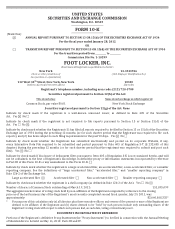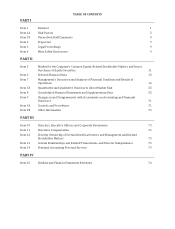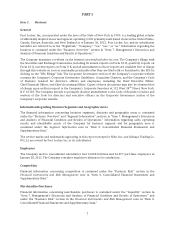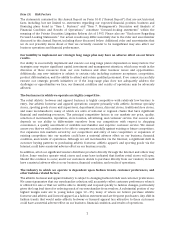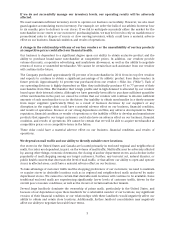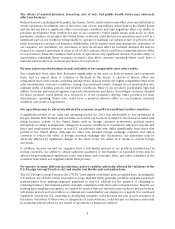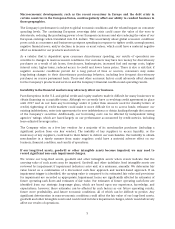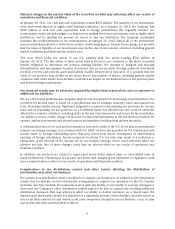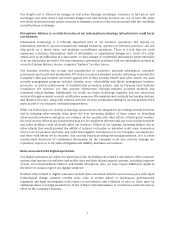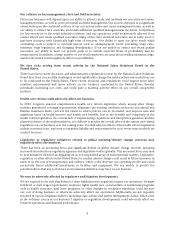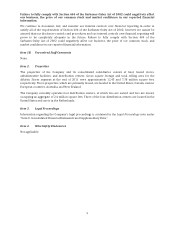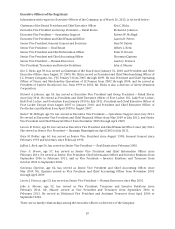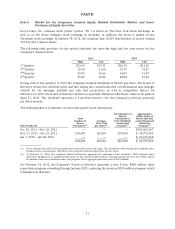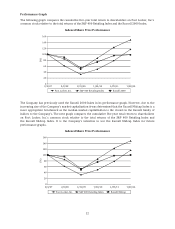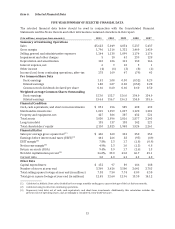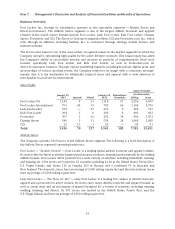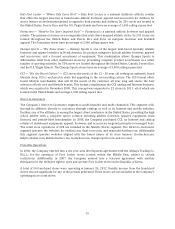Foot Locker 2011 Annual Report Download - page 25
Download and view the complete annual report
Please find page 25 of the 2011 Foot Locker annual report below. You can navigate through the pages in the report by either clicking on the pages listed below, or by using the keyword search tool below to find specific information within the annual report.Macroeconomic developments, such as the recent recessions in Europe and the debt crisis in
certain countries in the European Union, could negatively affect our ability to conduct business in
those geographies.
The Company’s performance is subject to global economic conditions and the related impact on consumer
spending levels. The continuing European sovereign debt crisis could cause the value of the euro to
deteriorate, reducing the purchasing power of our European customers and also reducing the value of our
European earnings when translated into U.S. dollars. This uncertainty about global economic conditions
poses a risk as consumers and businesses postpone spending in response to tighter credit, unemployment,
negative financial news, and/or declines in income or asset values, which could have a material negative
effect on demand for our products and services.
As a retailer that is dependent upon consumer discretionary spending, our results of operations are
sensitive to changes in macroeconomic conditions. Our customers may have less money for discretionary
purchases as a result of job losses, foreclosures, bankruptcies, increased fuel and energy costs, higher
interest rates, higher taxes, reduced access to credit and lower home prices. There is also a risk that if
negative economic conditions persist for a long period of time or worsen, consumers may make
long-lasting changes to their discretionary purchasing behavior, including less frequent discretionary
purchases on a more permanent basis. These and other economic factors could adversely affect demand
for the Company’s products and services and the Company’s financial condition and operating results.
Instability in the financial markets may adversely affect our business.
Past disruptions in the U.S. and global credit and equity markets made it difficult for many businesses to
obtain financing on acceptable terms. Although we currently have a revolving credit agreement in place
until 2017 and do not have any borrowings under it (other than amounts used for standby letters of
credit), tightening of credit markets could make it more difficult for us to access funds, refinance our
existing indebtedness, enter into agreements for new indebtedness or obtain funding through the issuance
of the Company’s securities. Additionally, our borrowing costs can be affected by independent rating
agencies’ ratings, which are based largely on our performance as measured by credit metrics, including
lease-adjusted leverage ratios.
The Company relies on a few key vendors for a majority of its merchandise purchases (including a
significant portion from one key vendor). The inability of key suppliers to access liquidity, or the
insolvency of key suppliers, could lead to their failure to deliver our merchandise. Our inability to obtain
merchandise in a timely manner from major suppliers could have a material adverse effect on our
business, financial condition, and results of operations.
If our long-lived assets, goodwill or other intangible assets become impaired, we may need to
record significant non-cash impairment charges.
We review our long-lived assets, goodwill and other intangible assets when events indicate that the
carrying value of such assets may be impaired. Goodwill and other indefinite lived intangible assets are
reviewed for impairment if impairment indicators arise and, at a minimum, annually. We determine fair
value based on a combination of a discounted cash flow approach and market-based approach. If an
impairment trigger is identified, the carrying value is compared to its estimated fair value and provisions
for impairment are recorded as appropriate. Impairment losses are significantly affected by estimates of
future operating cash flows and estimates of fair value. Our estimates of future operating cash flows are
identified from our strategic long-range plans, which are based upon our experience, knowledge, and
expectations; however, these estimates can be affected by such factors as our future operating results,
future store profitability, and future economic conditions, all of which can be difficult to predict. Any
significant deterioration in macroeconomic conditions could affect the fair value of our long-lived assets,
goodwill and other intangible assets and could result in future impairment charges, which would adversely
affect our results of operations.
5






